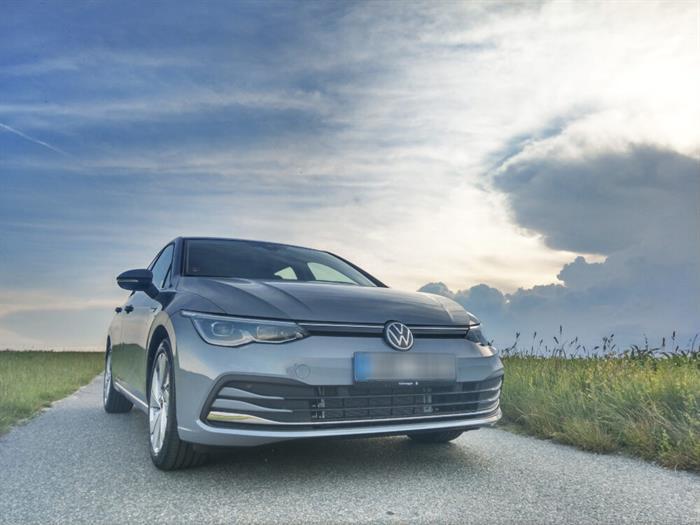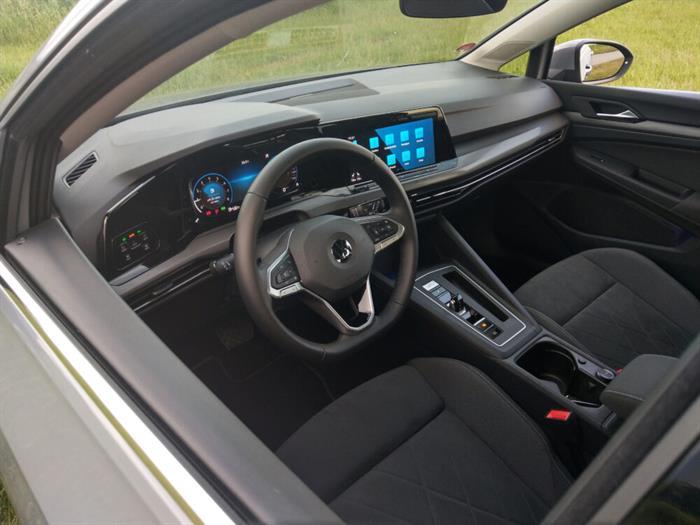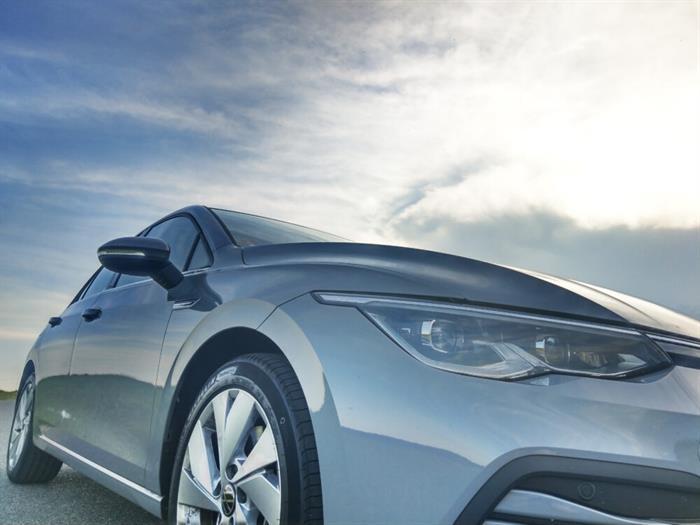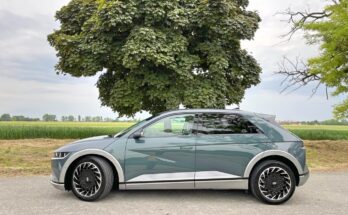One of the most important representatives of the lower middle class has currently passed the editorial test. And that representative was none other than the proven Volkswagen Golf. The Golf model has been with us since the 1970s, and Volkswagen is now offering it in its eighth generation.
The tested car was equipped with the new mild-hybrid 15-speed eTSI, which cooperated excellently with the seven-speed DSG automatic. The car also had the 1st Edition equipment, which is based on the Style trim level.

Exterior, changes mainly within the front part
My first "internet" encounter with the new generation Golf left me feeling a little embarrassed. The front part and its treatment were mainly to blame for these feelings. The eighth generation is still a classic Golf in its basic forms, but suddenly it comes with a quite unconventional concept of the announced front part. But I've already gotten quite used to the fact that when it comes to car design, there's no need to make hasty conclusions and always simply experience the car in real life.
And it was the same with the tested piece, my first steps lead precisely to the announced front part. It has a significantly low-slung and very subtle front mask, which is directly connected to the front LED Matrix IQ LIGHT headlights. Their daytime running lights (directional lights) create a discreet light line and demarcate their upper part. This line then directly connects to the chrome line of the front mask, which then has a light effect in the higher equipment levels and thus lends the new Golf a very elegant and stylish element. The front headlights with a strictly cut upper part then experience a certain playfulness in their lower part. Here, they are quite dynamically rebounded and then logically narrow towards the center of the car.

The slightly futuristic front part will also offer a very rich bumper cutout, which is horizontally divided by elegant "gills".
Other parts of the car quite playfully remind us of the previous generation Golf. So there were only light retouches and changes here. The side profile is further dominated by a relatively massive "C" column, which is effectively prescribed in the rear fender and at the same time elegantly terminates the rear lamps. They will then offer new graphics and diode technology.
However, the car company's logo, which is no longer plastic, received a new treatment. There is also a new position for the model designation, this has been significantly enlarged and moved to the middle of the fifth door, following the example of its siblings.
In terms of external design, the eighth generation primarily brings us a new concept of the front part. Thanks to the low-slung and significantly narrowed front mask, it can cause initial embarrassment, but believe me, you will definitely come to like it.

Interior, digitization and simplification
While the exterior of the new generation comes with a significant change mainly within the front part, the interior itself is much more imaginative and innovative.
The eighth generation of the Golf received the MIB 3 control center, which the new Octavia also has, for example. The interior, mainly the dashboard, has therefore undergone considerable simplification and many of the original controls have been moved to a digital environment. An approach that we have known for some time from, for example, French cars. Personally, I have no problem with this solution and I definitely appreciate the release of the dashboard that comes with this principle.
The innovative treatment of the interior is thus clearly visible at first glance. After sitting in the car, you will be pleasantly surrounded by a simple and airy dashboard. Its central motif is a broken "plate" stretching from the driver's door to the central tunnel. It then includes a fully digital instrument panel in front of the driver, an on-board infotainment display and exterior lighting controls. As for the graphics of both displays, I have no reservations here, both have excellent resolution and a very fast response.
The elegant horizontal proportions of the dashboard itself are completed by the air conditioning vents, which are very subtle in the context of the concept of the front mask, and are also lined with a discreet chrome line.
The minimization of the control elements brought a significant optical simplification to the interior, however, controlling the individual functions of the car requires initial practice. But once you get used to it, you'll find that it's very simple and intuitive. In the central part of the dashboard there are touch controls for quick selection, these are the climate control, driving assistants, driving mode selection or parking assistant. There are also touch "slider" controls under the on-board infotainment touchscreen, which you can use to adjust the radio volume, temperature or heated seats. Here I will admit that I preferred to control the radio volume directly from the excellent multifunction steering wheel and control the temperature via the on-board infotainment display. So, unfortunately, the touch "sliding" surfaces did not grow to my heart during the week-long test.
We also have the central tunnel, which, like the new Octavia, received a small automatic transmission selector. In the new generation Golf, the gear selector is thus integrated into one panel together with the start button, the parking brake controller and the auto hold system. This panel forms a very compact element within the central tunnel and gives this part of the interior a user-friendly airiness.
Another feature of the new eighth generation Golf is voice control. With the "Hey Volkswagen" spell, you activate an assistant who will try to fulfill "all" your wishes. You can currently use your voice to control the functions of the radio, telephone, air conditioning or navigation system. According to the automaker, the voice control system is still being improved and in the context of new updates, it should always be able to do a little more.
As a result, I must definitely praise the interior of the new generation Volkswagen Golf. From the first time I sat in the car, I really liked it. Its digitization brought a great saving of individual controllers and with it an enormous airiness. The interior looks very spacious, not to mention its excellent internal ergonomics.

Offered engines and driving impressions of the tested mild-hybrid 1500
The new generation Golf is currently available with four petrol and two diesel engines. The gasoline ones are represented by the basic liter 1.0 TSI engine with an output of 81 kW, as well as a pair of 1.5 TSI engines tuned to 96 and 110 kW. The range is rounded off by the 1.5 eTSI mHEV mild-hybrid engine tested by us, which also has 110 kW of power. The basic liter and both 1500 units are connected exclusively to a six-speed manual, while the mild-hybrid engine is connected to a seven-speed DSG automatic.
Diesel is then represented by 2.0 TDI engines, which provide 85 and 110 kW. A weaker diesel is available with a manual, a stronger one with a DSG automatic.
As I have already mentioned, we have currently tested the petrol turbocharged eTSI, which also had mild-hybrid technology. This drive unit offers a respectable 110 kW (150 hp) and 250 Nm of torque, which is available from 1,500 rpm.
The mild-hybrid technology in the car itself works with a 48 V network and a battery, in which energy is stored via the starter-generator using recuperation.
This motorization is only connected to a seven-speed DSG automatic, and their cooperation is very good in the case of the new Golf. I've always had good experiences with the DSG gearbox, but the recently tested T-Cross , which also had a turbocharged fifteen-cylinder and a DSG automatic, could sometimes be quite annoying when starting, thanks to a significant "twitch". Nothing like that happens with the tested Golf and the starts are always very smooth. Of course, this also applies if the start x stop system is activated. Thoughts of turning it off will pass you by very quickly in this car because you simply won't have a reason to.
The motorization tested is also characterized by a very refined and extremely quiet performance. Thanks to the excellent noise reduction, you hardly know about the engine in the cabin itself.
The new eighth generation with mild-hybrid technology is a great driving manager. The Golf manages to work in two-cylinder mode at low load, in case of acceleration, it can help itself with saved electrical energy, which it very successfully stores itself. Thanks to information from the navigation system or traffic signs, the car brakes and recovers by itself without your assistance. It is also a matter of course to drive with a disabled speed.
The new mild-hybrid Golf is therefore very diligent in saving fuel, I managed to consume around 6.5 liters with it during the week-long test.
In terms of chassis, our tested piece was equipped with an adaptive extra charge DCC chassis and a multi-link rear axle suspension. I definitely have to praise the DCC adaptive chassis, in the individual mode you can tune it to a softer position than the comfort mode itself offers, as well as to a harder one than the sport mode offers. The range of settings is therefore really large, the Golf is therefore very comfortable and buoyant with this chassis configuration, and at the same time it can tighten up and offer enough confidence. A slight disappointment for me was the slight bumping of the chassis on transverse bumps.

In conclusion
The Volkswagen Golf of the eighth generation, thanks to the digital interior and a rather unconventional front end, successfully tried to break out of its inveterate stereotype. And I definitely admire him for this approach. Its new front end may not be to everyone's taste, but give it a chance and you'll like it. Furthermore, there is a newly "digital" interior, which brought considerable refreshment and simplification not only to the dashboard.
The eighth generation will also please with a very comfortable driving performance, which was mainly the result of the tested mild-hybrid fifteen-seater and its excellent cooperation with the seven-speed DSG automatic. When I think about the occasional "banging", I also have to praise the work of the additional adaptive chassis.
And how is the price of the new Golf? The basic version, i.e. the Golf equipment level with a liter engine and a six-speed manual, starts at CZK 479,900 including VAT. You can buy the cheapest 2.0 TDI diesel with a six-speed manual in the Life trim from CZK 593,900 including VAT. The gasoline mild-hybrid we tested starts at CZK 653,900 including VAT. The purchase prices of the new generation can therefore rise significantly depending on the individual equipment levels. For a car that would be adequate for the piece we tested, you will have to prepare almost 800,000 CZK including VAT.
Source: Author's text
Image source: Author's own photos




























